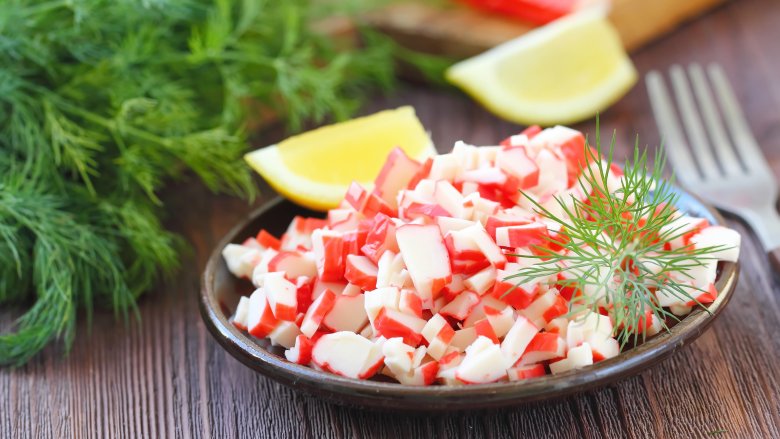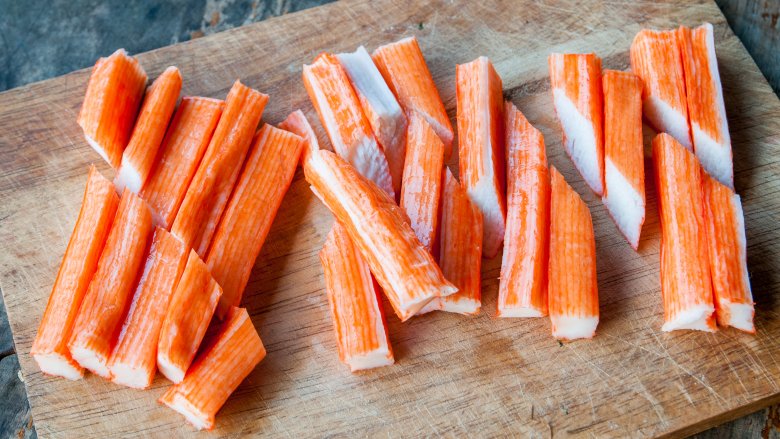What Is Imitation Crab Meat Actually Made Of?
With the word imitation in front of it, it's definitely no secret that imitation crab is far from the real thing. That tightly packed red-and-white impostor you'll find displayed in the seafood section of the grocery store may resemble crab, but it's not really made of crab at all. So, what exactly is in imitation crab and is it worth your money?
While you won't find any crab meat in the imitation crab, you will find seafood — imitation crab is made up of a paste called surimi, which is basically processed, mashed-up fish. It's usually a combination of fish such as Alaskan pollock or Pacific whiting fish that have been put through a complicated manufacturing process and turned into a gel-like substance (via Thrillist). A seafood paste might not exactly sound all that delicious, so in order to create the right taste and texture that you'll find in your California roll, manufacturers add in starches, sugars, artificial flavorings, and sometimes MSG (via SF Gate). All of these additives significantly decrease the nutritional value of imitation crab and it can become a menu item that those who are gluten-free should stay far away from.
Is imitation crab healthy?
It's hard to believe that a highly processed food has been considered a delicacy for over 900 years. Surimi was first created by Japanese chefs who were looking for a way to use leftover fish. That creation eventually became the foundation of imitation crab and since then, its popularity has only grown. It's no surprise that restaurants love it because imitation crab serves as a low-cost alternative to the real thing. With that, though, comes some definite drawbacks.
For starters, real crab meat is simply healthier than imitation crab, as it has more Omega-3 fats, less sugar, and more protein, and vitamins such as B12 and zinc (via Healthline). When you dine on imitation crab meat, you will ingest less sodium than if you have a plate of the real thing in front of you, so if that's something you're trying to watch in your diet, then you may want to consider this seafood alternative.
While imitation crab meat does have a lot of preservatives to help extend its shelf life, you'll need to treat the product similar to how you would keep fish. According to The Los Angeles Times, if it's vacuum-sealed you shouldn't have any trouble keeping it in the fridge for up to two months before opening it. If you buy it frozen, it should stay good in your freezer for around six months. Once that imitation crab has been opened or thawed out though, you have around three days — five if you want to push the envelope — before it spoils. You'll know pretty quickly, too, that it's gone bad by the sour taste and foul stench.
Should you buy imitation crab meat?
Nobody's going to argue that crab cakes can't be a little pricey on seafood restaurant menus, so on that front, imitation crab has some obvious benefits. It's cheap and works as a quick option when adding to a seafood salad or dip. Its lower protein and higher sugar content aside, it's easy to see why imitation crab has become so popular. However, ocean environmentalists might even say that this bargain seafood product has become a little too popular.
In order to keep up with the demand and make enough imitation crab to go around, large amounts of pollock must be harvested, and this has some concerned about the potential for overfishing (via Talking Fish). Making sure the fish used for imitation crab has that appealing crabby appearance also involves a lot of water to improve its color and texture of the meat. This can lead to wastewater pollution if improperly discharged into the ocean (via Associated Press).
No one is going to tell you not to enjoy your sushi or seafood salad. As long as you're okay with the fact that you're probably not consuming any crab at all, go for it. We can't argue with saving a few bucks for what may taste almost like the real thing. If you can't fake it, though, and are looking for crab that's real and authentic, know that the only crab you should be ordering is the one that comes straight from the sea — not spit out of a grinder at a manufacturing plant.


